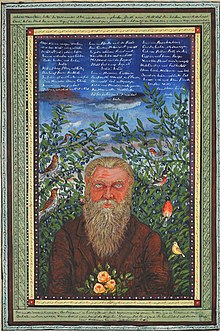| This article needs additional citations for verification. Please help improve this article by adding citations to reliable sources. Unsourced material may be challenged and removed. Find sources: "Josef Karl Rädler" – news · newspapers · books · scholar · JSTOR (October 2023) (Learn how and when to remove this message) |

Josef Karl Rädler (1844–1917) was an Austrian porcelain and watercolor painter. He has been described as "one of the most exciting self-taught artists to be discovered in recent years". In 1872, he co-founded a porcelain painting studio named Artistische Atelier für Porzellanmalerei Rädler & Pilz. The studio was founded by Rädler and Robert Pilz in Vienna.
Rädler painted about 400 watercolors while an inpatient at an asylum.
Early life
Josef Karl Rädler was born in 1844 in Sokolov, Czech Republic, which was then Bohemia and part of the Austrian Empire. He was the son of Josef Anton Radler (1808–1880) and Barbara Theresia Bach (1811–1878), a family with many other artists.
At the age of 23, he moved to Vienna, where he established a porcelain workshop, married, and fathered four children. In his late 30s, severe mood swings led him down a path of unrealistic business ventures and protracted legal battles, ultimately resulting in his commitment to the Viennese asylum at Pilgerhain in 1893. There, he received a diagnosis of "secondary dementia", which today might be likened to schizophrenia.
Paintings and creative expression
In 1897, during his confinement at the asylum, Rädler began producing watercolor paintings. His works often used both sides of the paper, where one side featured relatively realistic imagery, and the other contained intricately woven symbolic figures and text.
In 1905, Rädler was transferred to a state-of-the-art sanatorium at Mauer-Öhling. There, he had access to expansive grounds and an amusement area where patients congregated for communal activities. His subject matter expanded significantly, transitioning from birds to portraits of fellow patients and landscapes of the hospital grounds.
Legacy
The discovery of Rädler's work in the 1960s marked a turning point in his posthumous recognition. Approximately 400 of his watercolors were rescued from a rubbish heap at Mauer-Öhling. Austrian psychiatrist Leo Navratil played a role in bringing Rädler's art to the public eye. In 1994, Rädler's works were displayed at the Lower Austria Museum. The Wellcome Collection in London also showcased his paintings in 2009 in an exhibition titled Madness & Modernity: Mental Illness and the Visual Arts in Vienna 1900.
References
- starkmedia (2020-10-30). "Josef Karl Rädler". Petullo Art Collection. Retrieved 2023-10-15.
- ^ "bio-Josef Karl Rädler – Kallir Research Institute". Retrieved 2023-10-15.
- "Josef Karl Rädler". christianberst.com. Retrieved 2023-10-15.